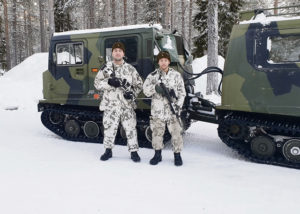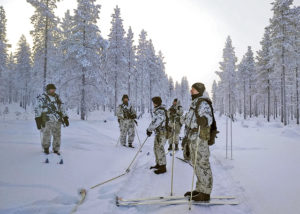
ROVANIEMI, Finland —Subarctic temperatures didn’t stop a multinational training exercise from going forward during a Winter Combat Course near Rovaniemi, Finland, located just four miles south of the Arctic Circle, during the freezing month of January, the coldest month of the year in the region.
With temperatures reaching as low as -37 degrees Celsius and a landscape covered with a meter of snow, two U.S. Soldiers assigned to U.S. Army Health Clinic Kaiserslautern joined the two-week long exercise, familiarizing themselves with topics such as using layered clothing, protecting against and treatment of injuries relating to frostbite, sustaining performance capability, making fire by using ad hoc tools, getting versatile skiing practice (including cross-country skiing downhill and uphill, skiing skills track, and skiing with and without a rucksack) and marksmanship practice with and without night vision equipment also on skis, utilizing snow vehicles, fortifying in snow, and conducting combat operations in snowy conditions.
“I’ve never done winter warfare training before: it was just a world of difference,” said U.S. Army Capt. Samuel Pankonen, the chief nursing officer at Kaiserslautern Army Health Clinic. “The focus of the training is to make sure we have action competence.”
According to Pankonen, the course immersed participants in the arctic climate with minimal equipment to test survivability, lethality and collaboration.
“(The Finnish Army) wanted us to be able to operate in the environment that we were being exposed to,” said Pankonen, a native of Wisconsin Rapids, Wisconsin. “With the extreme cold and having (simulated) enemies trying to kill you, we had to operate at that most basic unit function and carry on the mission.”
Last year the Army introduced the Regionally Aligned Readiness and Modernization Model, a flexible, predictable force generation process that will create an Army that is regionally and functionally capable of supporting the nation’s defense strategy. Part of those efforts include a new Arctic strategy to increase the ability to protect assets in Arctic regions while continuing to recalibrate its forces around the world to deter near-peer adversaries.

“Optimizing the employment of our forces and being able to demonstrate our capabilities through combined exercises and power projection are critical,” said U.S. Army Chief of Staff Gen. James C. McConville, in an Association of the U.S. Army report. “We are focused on maintaining and enhancing those relationships.”
The course, part of arctic warfare training, is led by the Finnish Army’s Jaeger Brigade and aims for designation as a training center of excellence for arctic training.
“That was the first time I got on skis; I had never put on skis before,” said U.S. Army Staff Sgt. Elias Bonilla, a laboratory technician at Kaiserslautern Army Health Clinic. “At first I was like, ‘I don’t know if I can do this.’ But (Finnish instructors) taught us the basics and that really helped set the pace for the next two weeks of training.”
By the end of the course, Bonilla, a native of Los Angeles, was skiing while shooting a weapon and maneuvering across rough terrain.
During the second week of the course students were tasked with a four-day live fire exercise in which they remained outside throughout the duration of the event.
While the training grounds are a very hostile environment, Pankonen said that student wellbeing was also at the forefront of the course.
“The instructors highly encouraged and almost sometimes forced us to stop what we were doing to eat or rest,” explains Pankonen. “Shelter and security are important but you need to rest because the environment is (unforgiving).”
When asked about any difficulties training with foreign militaries or service members of other occupations, Pankonen said their differences didn’t matter in the training environment.
“We all wear the same uniform over there. We all respect each other for the choice to serve. There’s just a certain brotherhood,” he said. “I’m an Army nurse. I don’t get to do cool (training like this), very often. But that sits in my head when I go to something like this but as the training went on, I proved I could hold my own.
“I know what I’m doing, I’m a Soldier first,” said Pankonen.
“You want to be able to train your Soldiers, not only the Soldiers but yourself,” said Bonilla. “I’m a (laboratory technician) but I’ve been cross trained to cover down for medics in any unit. It comes down to knowing the equipment that you’re going to be utilizing and knowing yourself.”







